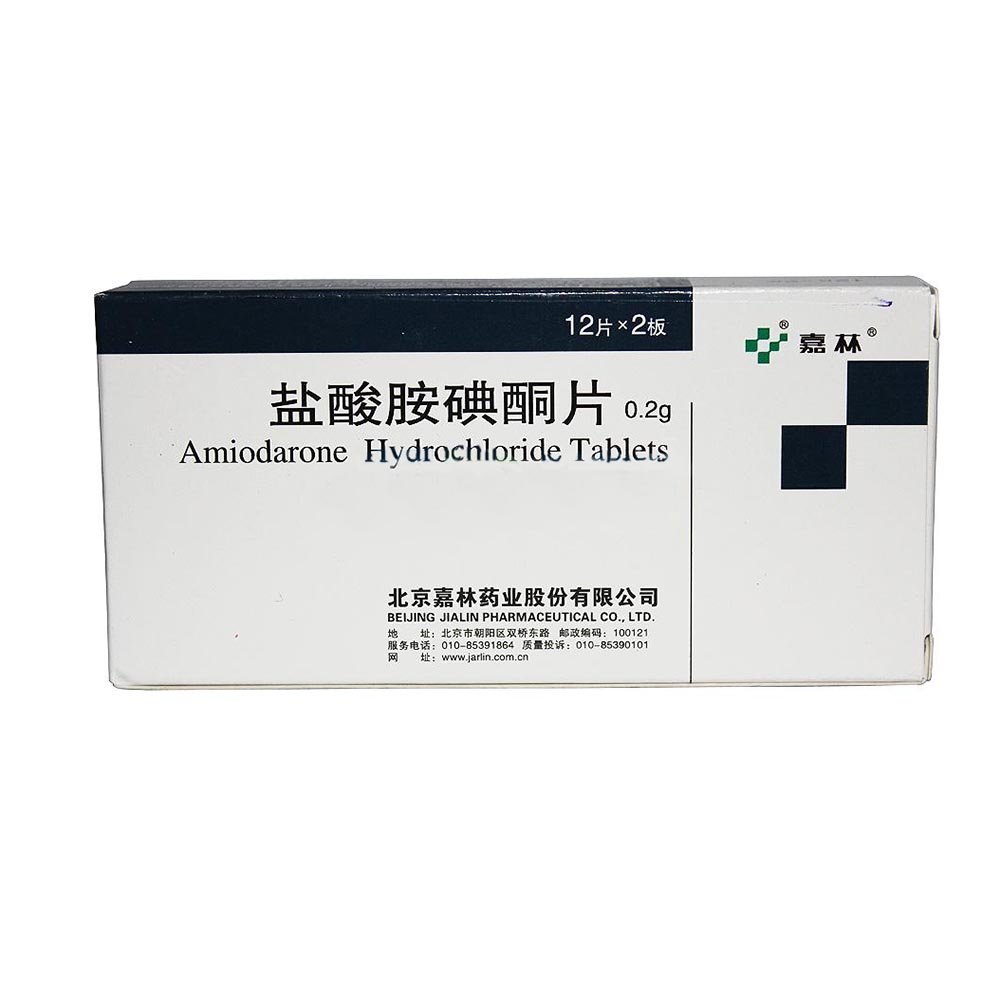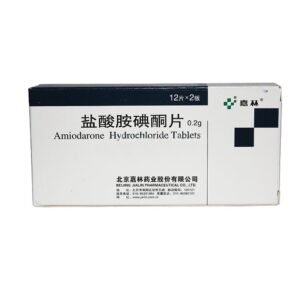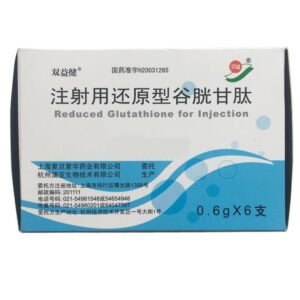Amiodarone Hydrochloride Tablets
Effects and efficacy:
Amiodarone hydrochloride tablets and dispersible tablets for atrial arrhythmias (conversion of atrial flutter, atrial fibrillation and maintenance of sinus rhythm after conversion). Nodal arrhythmias. Ventricular arrhythmias (treatment of life-threatening premature ventricular contractions and ventricular tachycardia, and prevention of ventricular tachycardia or ventricular fibrillation). Arrhythmias associated with W-P-W syndrome. Based on its pharmacological characteristics, amiodarone is suitable for the above-mentioned arrhythmias, especially patients with organic heart disease (coronary artery insufficiency and heart failure). Oral amiodarone hydrochloride capsules are suitable for the prevention of life-threatening paroxysmal ventricular tachycardia and ventricular fibrillation. It can also be used for paroxysmal supraventricular tachycardia, paroxysmal atrial flutter, and atrial fibrillation that are ineffective with other drugs, including those with preexcitation syndrome and maintenance treatment after electrical cardioversion of persistent atrial fibrillation and atrial flutter. It can be used to control the ventricular rate during persistent atrial fibrillation and atrial flutter. Unless there are clear indications, it is generally not suitable for the treatment of atrial and ventricular premature beats. Amiodarone hydrochloride injection is used to treat severe arrhythmias when oral administration is not suitable, especially in the following situations: atrial arrhythmias with rapid ventricular rhythms. Tachycardia in W-P-W syndrome. Severe ventricular arrhythmias. Cardiopulmonary resuscitation of ventricular fibrillation-related cardiac arrest that is ineffective with external defibrillation.
Usage and Dosage:
Loading dose of amiodarone hydrochloride tablets and dispersible tablets: usually 600 mg per day, which can be used continuously for 8-10 days. Maintenance dose: The minimum effective dose should be used. Depending on individual response, 100-400 mg per day can be given. Due to the prolonged therapeutic effect of amiodarone, 200 mg every other day or 100 mg per day can be given. Intermittent treatment methods have been recommended to stop the drug for two days per week. Amiodarone hydrochloride capsules are taken orally. The common dosage for adults to treat supraventricular arrhythmias is 0.4-0.6g per day, divided into 2-3 doses. After 1-2 weeks, it can be changed to 0.2-0.4g per day for maintenance as needed. Some patients can be reduced to 0.2g, 5 days a week or less for maintenance. For the treatment of severe ventricular arrhythmias, 0.6-1.2g per day, divided into 3 doses, and after 1-2 weeks, it can be gradually changed to 0.2-0.4g (1-2 tablets) per day for maintenance as needed. For pharmaceutical reasons, amiodarone hydrochloride injection should not be used at a concentration of less than 2 ampoules of injection in 500ml. Only isotonic glucose solution is used for preparation. Do not add any other preparations to the infusion. Amiodarone should be administered through the central venous route as much as possible. Based on the clinical research experience of amiodarone hydrochloride injection, regardless of the patient’s age, renal function, and left ventricular function, a maintenance infusion of 0.5mg/min can be cautiously continued for 2 to 3 weeks. There is limited experience in patients receiving amiodarone hydrochloride injection for more than 3 weeks. There is a large difference between individuals in amiodarone hydrochloride, and a loading dose is required to suppress life-threatening arrhythmias, while precise dose adjustments are made. The initial dose is usually 1000 mg of amiodarone hydrochloride given within 24 hours, which can be administered according to the following usage. Recommended dose of amiodarone hydrochloride injection Loading infusion for the first 24 hours: Fast first, 150 mg (15 mg/min) in the first 10 minutes. 3 ml injection (150 mg) in 100 ml glucose solution (concentration = 1.5 mg/ml). Infuse for 10 minutes. Slow then, 360 mg (1 mg/min) in the next 6 hours. 18 ml injection (900 mg) in 500 ml glucose solution (concentration = 1.8 mg/ml). Maintenance infusion: 540 mg (0.5 mg/min) for the remaining 18 hours. Reduce the infusion rate to 0.5 mg/min. After the first 24 hours, the infusion rate is maintained at 0.5 mg/min (720 mg/24h) at a concentration of 1-6 mg/ml (amiodarone hydrochloride injection concentrations above 2 mg/ml require administration through a central venous catheter) and the infusion should be continued. When ventricular fibrillation or hemodynamically unstable ventricular tachycardia occurs, an additional 150 mg of amiodarone hydrochloride injection can be administered in 100 ml of glucose solution. Administration should be done over 10 minutes to reduce the occurrence of hypotension. The rate of maintenance infusion can be increased to effectively suppress arrhythmias. Cardiopulmonary resuscitation of ventricular fibrillation-related cardiac arrest that is resistant to external defibrillation Based on the route of administration of amiodarone and the application status of the indication, a central venous catheter is recommended if it is immediately available; otherwise, the largest peripheral vein is used and the highest flow rate is administered through the peripheral intravenous route. The initial intravenous dose is 300 mg (or 5 mg/kg), diluted in 20 ml of 5% glucose solution and injected rapidly. If ventricular fibrillation persists, an additional 150 mg (or 2.5 mg/kg) should be considered intravenously. Do not add any other drugs to the syringe. The same drugs produced by different manufacturers may have inconsistent instructions. If you find that the instructions are inconsistent before taking the medicine, please consult a doctor or pharmacist in time.
Drug contraindications:
Allergic to this product is prohibited during pregnancy and lactation. Use with caution in case of liver damage
Related dosage forms:
Tablets, dispersible tablets, capsules, injections
Share:
Products
Our offers
Health Classification
Let us work together to protect precious health

































